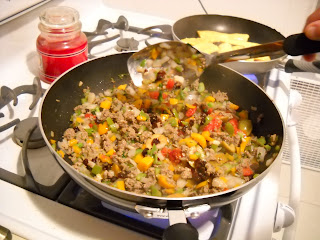"The ear tests words as the palate tastes food." -Job 34:3
New Chefs has been riding high on the 'learn a new word' and the 'bananas are awesome' themes recently, so for this post I'd like to bring the two together. Introducing...
the Pastelón!
"Heavens to Murgatroyd!" you might be saying. But fear not, readers! The pastelón is your friend. And what a friend it will be...
New Chefs' discovery of pastelón came about when my dear friend Chelsea noticed that plantains were being sold 10 for a dollar at a store in my neighborhood. I was quite hesitant at first. I mean... have you seen what a ripe plantain looks like?!

(the ones on the left there)...
Ripe plantains look alarmingly like rotting bananas. Well...Cavendish bananas...since plantains are technically bananas too. And if I had a banana that ripe, I'd be making banana ice cream out of it as a last resort!
Yet as it turns out, when plantains do get this black, they're quite acceptable for cooking- as are the green plantains. It all depends on which flavor you want. When the plantain is green, it's starchy and works well with savory flavors. When the plantain is black, the taste is much sweeter.
So we had an abundance of plantains... (By the way, plantain season runs from May to September, so you'll have an abundance too.) What we decided to do, thanks to a recipe found on Food Gawker, was make pastelón.
The pastelón, in the simplest sense, is like lasagna- but with plantains instead of pasta. Honestly, I would tout this recipe as the best to hit the site yet. This pastelón has such a unique flavor- perhaps because I don't traditionally eat Puerto Rican cuisine. It's sweet...and yet savory...and the colors, oh, the colors! Whatever the case, I insist you give this a try. Other than the plantains, you've probably got most of the ingredients in your kitchen!
Pastelón
- 1 lb ground beef
- 1 onion, minced
- 3 cloves garlic, minced
- 1 small green pepper, minced
- 1 small orange pepper, minced
- 1 c chopped cilantro
- 2 tsp adobo
- 2 tsp oregano
- 2 tbsp vinegar
- 1 envelope sazón seasoning
- 8 green stuffed olives, quartered
- 1/2 c raisins
- 1/4 c diced tomatoes
- 4 plantains, peeled and sliced into strips (try and get them when they're very black)
- 3 eggs
- 2 tbsp milk
- 2 cups shredded white cheese
- vegetable oil
Directions:
- Pre-heat the oven to 350 degrees F. Butter a 9 x 9 pan with cooking spray or butter.
- Mix beef, onion, peppers, garlic, cilantro, adobo, oregano, vinegar, and sazón in a bowl.
- In a large skillet over medium-high heat, heat 2 tbsp of olive oil and add meat mixture. Cook the mixture until the beef is brown and the juices bubble clear. Add the olives, raisins, and tomatoes. Mix and simmer for 10 minutes. Remove from heat and set aside.
- In a large frying pan, heat up enough vegetable oil to coat the bottom. Fry the plantain slices for about 2-3 minutes on each side, or until they are golden and a bit crispy. Place cooked slices on a plate with paper towel to drain.
- Piece together the pastelón in the square pan. First, make a layer of plantains. Cover this with half of the meat mixture, then a fistful of cheese. Make a second layer of plantains and cover with remaining meat mixture. Add another handful of cheese and one final layer of plantains.
- Beat eggs and milk together. Pour over the pastelón and give it a minute to soak in. Add more cheese here if you like!
- Bake in the oven for 20 minutes and enjoy :)







